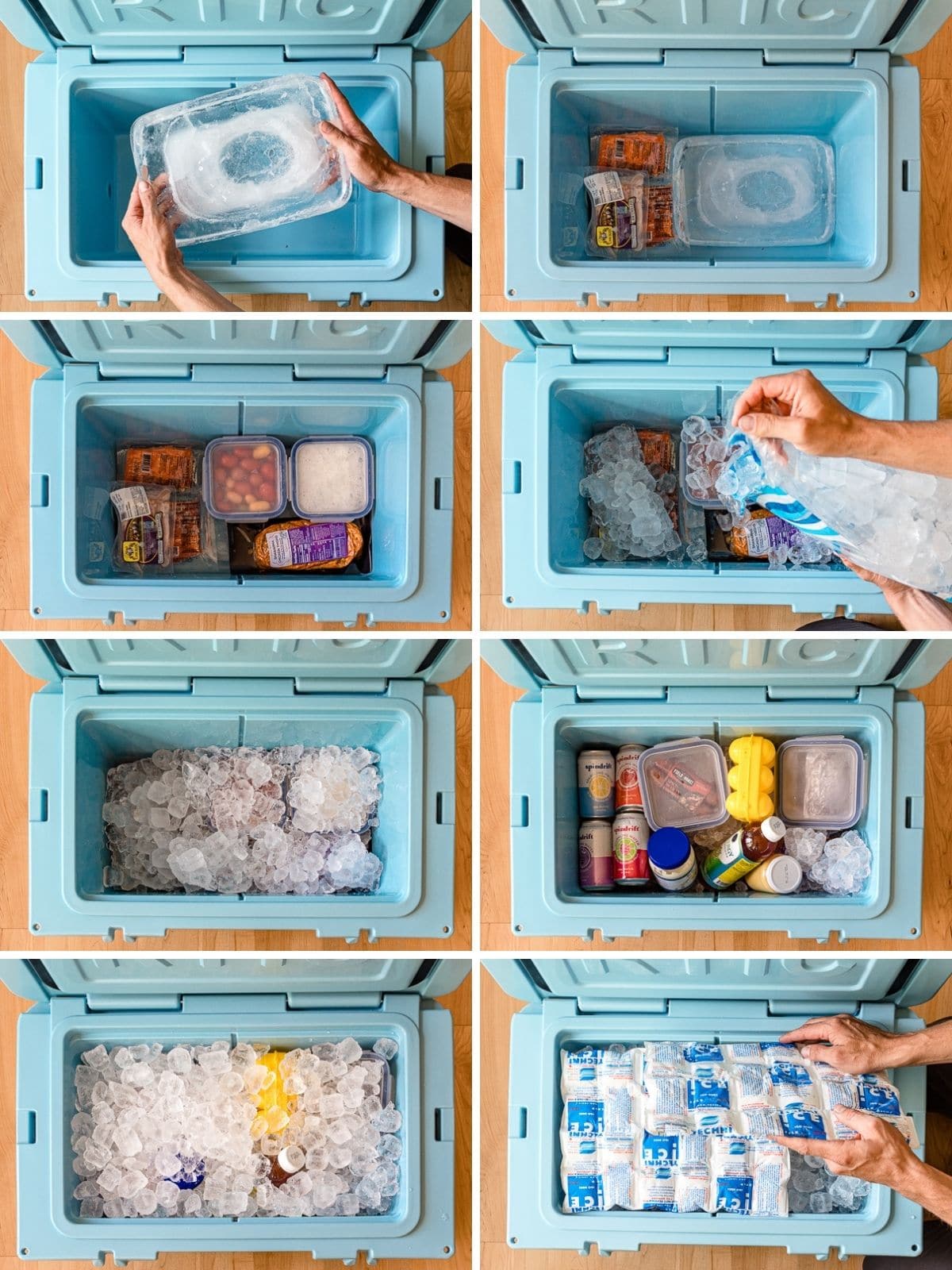What is the best way to pack a cooler for camping? The best way to pack a cooler for camping involves pre-chilling the cooler and food, layering correctly with ice on the bottom, keeping food organized, and minimizing how often you open the cooler. These cooler packing tips camping will help keep your food cold and safe for your camping trip. Let’s dive into the secrets of keeping your food and drinks icy cold during your outdoor adventures!

Image Source: www.freshoffthegrid.com
The Importance of Efficient Cooler Packing Camping
Camping is awesome! But food safety is key. Warm food can spoil quickly, leading to unwanted illness. A well-packed cooler keeps your food at safe temperatures longer. It also saves space and prevents a soggy mess. Think of it as a crucial skill for every successful camper.
Preventing Food Spoilage While Camping
Nobody wants a stomach ache in the woods. Keeping food cold camping stops bacteria from growing. Bacteria love warmth and moisture. Cold temperatures slow them down.
Maximizing Cooler Space
A well-organized cooler fits more. You don’t want to bring two coolers when one will do. Good cooler packing strategies camping helps you use every inch wisely.
Reducing Ice Consumption
Less melted ice means less waterlogged food. It also means less need to buy more ice. Learning how to prolong cooler ice life saves you money and hassle.
Choosing the Right Cooler
Before you even start packing, you must pick the right cooler. Not all coolers are created equal. Consider these factors:
Cooler Types: Insulated vs. Electric vs. Soft-Sided
- Insulated Coolers: These are the most common. They rely on insulation to keep things cold. The thicker the insulation, the better.
- Electric Coolers: These plug into a car outlet. They can keep food cool or even frozen. They need power, though.
- Soft-Sided Coolers: These are lightweight and easy to carry. They are not as good at keeping things cold for long.
Size and Capacity Considerations
Think about how much food you need. A weekend trip needs less space than a week-long adventure. Choose a cooler that fits your needs without being too bulky.
Durability and Construction
Camping can be rough. A sturdy cooler can handle bumps and scrapes. Look for coolers made with durable materials.
Prepping Your Cooler Before Packing: The Key to Success
Proper prep is half the battle. Taking a few steps beforehand can dramatically improve your cooler’s performance.
Pre-Chilling the Cooler
A warm cooler will melt ice faster. Chill it before you pack.
* Method: Put ice packs or ice in the cooler the day before. You can also use frozen water bottles.
* Why it works: It lowers the cooler’s temperature before you add your food.
Pre-Freezing Food and Drinks
Frozen items act as ice packs. They also stay fresh longer.
* Examples: Freeze meats, drinks, and even water jugs.
* Benefit: Everything stays colder for longer.
Choosing the Right Ice: Types and Forms
Ice is not just ice. Different types have different melt rates.
| Type of Ice | Melt Rate | Pros | Cons |
|---|---|---|---|
| Block Ice | Slow | Lasts longer, melts slower | Takes up more space, can be harder to find |
| Cube Ice | Fast | Easy to find, fills gaps well | Melts quickly |
| Gel Packs | Medium | Reusable, doesn’t make food soggy | Doesn’t cool as quickly as ice |
| Dry Ice | Very Slow | Extremely cold, great for long trips | Can freeze food solid, requires careful handling |
Cooler Packing Strategies Camping: Step-by-Step Guide
Now for the fun part: packing your cooler like a pro.
Layering Techniques: The Cold Zone System
Layering is crucial for efficient cooler packing camping.
- Bottom Layer: Ice: This is the foundation. Use block ice for longer-lasting cold.
- Next Layer: Heavy Items: Place items like frozen meat and drinks on top of the ice.
- Middle Layer: Dense Foods: Add cheeses, yogurt, and other dense foods.
- Top Layer: Delicate Items: Put fruits, vegetables, and sandwiches on top. Keep them dry.
- Final Touch: A Towel: Cover everything with a towel to insulate and absorb moisture.
Food Organization: Preventing Cross-Contamination
Keep raw meat separate. Use airtight containers.
- Raw Meat: Store in sealed bags at the bottom. This prevents drips onto other foods.
- Dairy and Eggs: Keep in their original containers. Place them in the middle layer.
- Fruits and Vegetables: Store in bags or containers. This prevents bruising and keeps them fresh.
- Drinks: Store in a separate section if possible. Opening the cooler for drinks lets warm air in.
Minimizing Air Space: Fill the Gaps
Air is the enemy. Fill empty spaces with extra ice, towels, or crumpled newspaper. This helps maintain a consistent temperature.
Maintaining Your Cooler During the Camping Trip
Packing is just the beginning. You need to maintain your cooler throughout the trip.
Limiting Cooler Opening
Every time you open the cooler, warm air gets in. Plan ahead. Take out everything you need at once.
Draining Melted Ice (If Applicable)
Some coolers have a drain plug. Drain melted ice regularly. This keeps food from sitting in water.
Repacking and Re-Icing Strategies
If you’re on a long trip, you may need to re-ice. Buy more ice as needed. Repack the cooler using the layering method.
Camping Food Storage Cooler: Beyond the Cooler
Sometimes a cooler isn’t enough. Consider these additional storage options.
Bear-Resistant Containers
If you’re camping in bear country, you need bear-resistant containers. These keep animals away from your food.
Hanging Food from Trees
Another option in bear country is to hang your food from a tree. Make sure it’s high enough and far enough from the trunk.
Dry Food Storage
For non-perishable items, use airtight containers. Store them in a cool, dry place.
Advanced Cooler Packing Hacks Camping
Want to take your cooler game to the next level? Try these advanced techniques.
Using Reflective Materials
Wrap your cooler in a reflective blanket. This reflects sunlight and keeps the cooler cooler.
CO2 Ice vs. Water Ice
CO2 ice (dry ice) is much colder than water ice. It can keep things frozen for days. Handle it with care. It can cause burns.
Vacuum Sealing Food
Vacuum sealing removes air from food packages. This helps food stay fresh longer. It also saves space.
Troubleshooting Common Cooler Problems
Even with the best planning, problems can arise. Here’s how to handle them.
Dealing with Soggy Food
Prevent soggy food by using airtight containers. Place a towel at the bottom of the cooler to absorb moisture.
Ice Melting Too Quickly
Make sure your cooler is pre-chilled. Use block ice instead of cube ice. Limit how often you open the cooler.
Odor Control
Baking soda absorbs odors. Place an open box of baking soda in the cooler. You can also use charcoal briquettes.
Choosing the Best Camping Cooler
With so many options, picking the right cooler can feel overwhelming. Here are some top recommendations.
Top Cooler Brands and Models
- Yeti: Known for their durability and ice retention. Pricey, but worth it for serious campers.
- RTIC: Offers similar performance to Yeti at a lower price point.
- Coleman: A budget-friendly option. Good for shorter trips.
- Igloo: Another affordable brand. They offer a variety of sizes and styles.
Factors to Consider When Purchasing
- Insulation: Look for thick insulation for better ice retention.
- Size: Choose a size that fits your needs.
- Durability: Consider the materials and construction.
- Features: Look for features like drain plugs, handles, and bottle openers.
Fathoming Ice Retention Camping Cooler
A good cooler should keep ice for days. Here’s how to maximize ice retention.
The Science Behind Ice Retention
Insulation slows down the transfer of heat. The thicker the insulation, the slower the heat transfer. This keeps ice frozen longer.
Tips for Maximizing Ice Retention
- Pre-Chill: Chill the cooler and food before packing.
- Use Block Ice: Block ice melts slower than cube ice.
- Minimize Opening: Limit how often you open the cooler.
- Insulate: Wrap the cooler in a reflective blanket.
- Keep in Shade: Park the cooler in a shady spot.
FAQ: Frequently Asked Questions
- Can I use dry ice in my cooler? Yes, but use caution. Dry ice is extremely cold. It can freeze food solid. Wrap it in newspaper or a towel to protect food.
- What’s the best way to pack drinks in a cooler? Freeze some drinks beforehand. Place them at the bottom of the cooler. Keep drinks separate from food if possible.
- How long will food stay cold in a cooler? It depends on the cooler and how well you pack it. A good cooler can keep food cold for 2-5 days.
- What do I do if my cooler starts to smell? Clean it with soap and water. Place an open box of baking soda inside to absorb odors.
- Are electric coolers worth it? They can be. They keep food cold without ice. But they need a power source. They’re good for car camping.
- How do I prevent my cooler from leaking? Make sure the drain plug is tightly closed. Use airtight containers to prevent spills.
Mastering how to pack a cooler for camping is essential for any outdoor enthusiast. By following these cooler packing hacks camping, you’ll ensure your food stays fresh, your drinks stay cold, and your camping trips are enjoyable and safe. Happy camping!

Melody Smith is a passionate writer, outdoor enthusiast, and camping expert based in the Seattle Metropolitan Area. With a deep love for nature and adventure, she shares her personal experiences, tips, and insights on MyCampingPro.com. A seasoned camper and traveler, Melody combines her creative background in design and writing with her love for the great outdoors, offering practical advice and inspiring stories to help others make the most of their outdoor experiences. When she’s not exploring the wilderness, you can find her painting, collecting vintage treasures, or diving into a good book.
